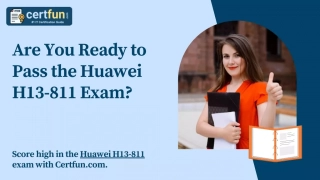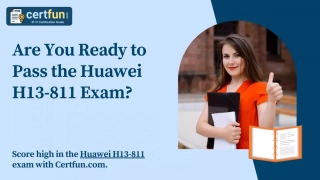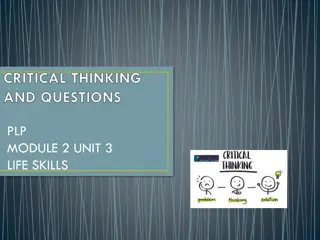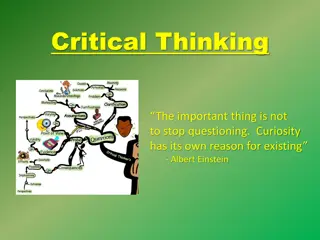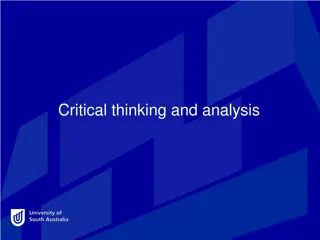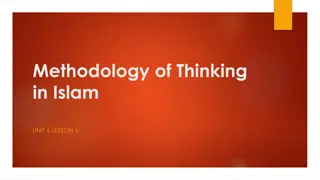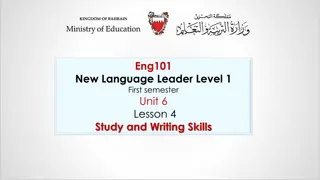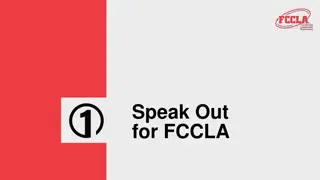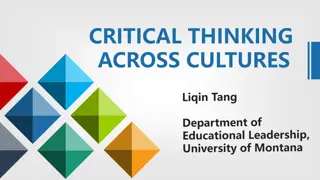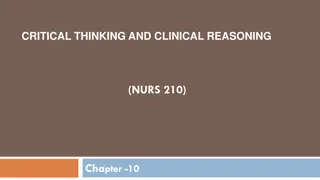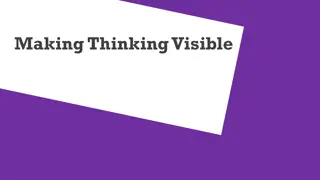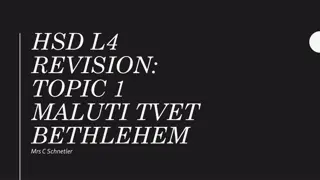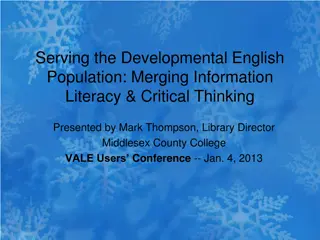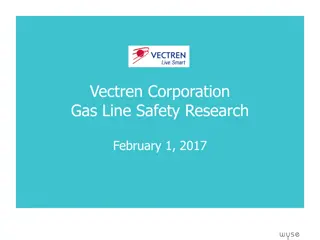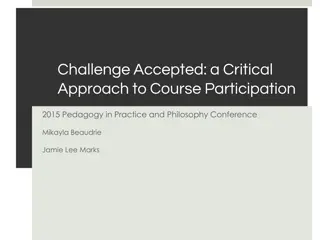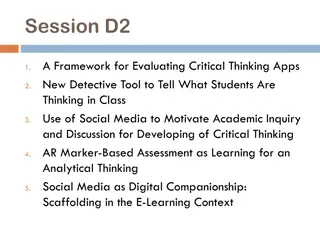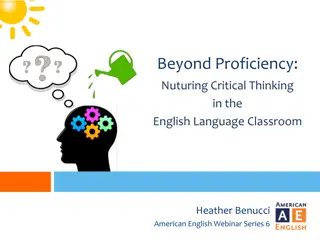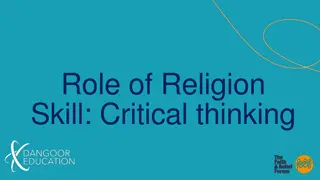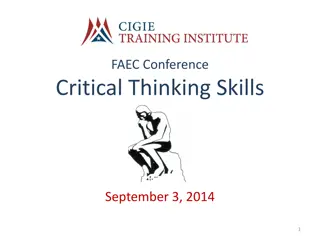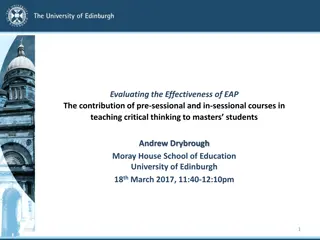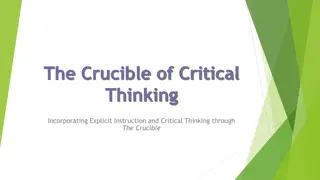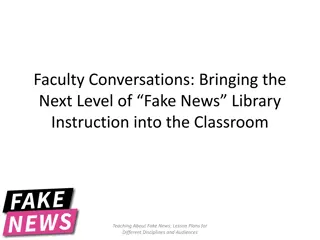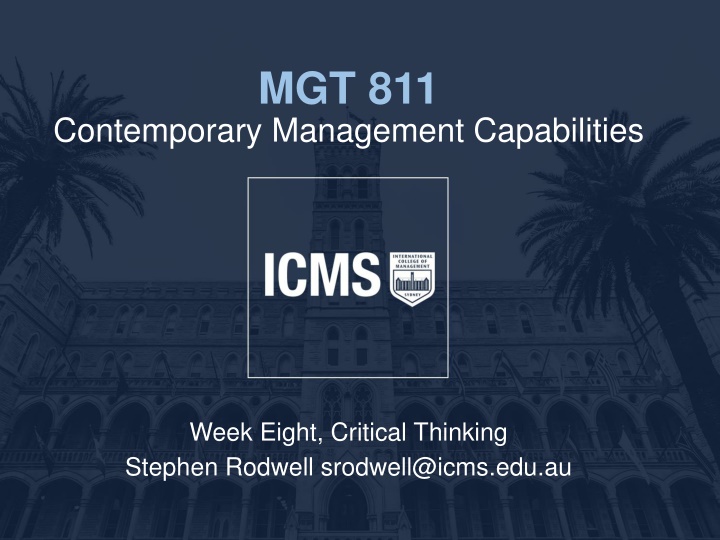
Enhancing Critical Thinking Skills for Effective Decision Making
Discover the essence of critical thinking, its benefits, and how it fosters in-depth analysis and reflection. Explore the key components of critical thinking, including questioning beyond the obvious, evaluating beliefs against facts, active listening, and searching for evidence to support assumptions. Experience the transformative journey of becoming a curious, open-minded critical thinker eager to explore diverse perspectives and embrace change.
Download Presentation

Please find below an Image/Link to download the presentation.
The content on the website is provided AS IS for your information and personal use only. It may not be sold, licensed, or shared on other websites without obtaining consent from the author. If you encounter any issues during the download, it is possible that the publisher has removed the file from their server.
You are allowed to download the files provided on this website for personal or commercial use, subject to the condition that they are used lawfully. All files are the property of their respective owners.
The content on the website is provided AS IS for your information and personal use only. It may not be sold, licensed, or shared on other websites without obtaining consent from the author.
E N D
Presentation Transcript
MGT 811 Contemporary Management Capabilities Week Eight, Critical Thinking Stephen Rodwell srodwell@icms.edu.au
Outline for today What is critical thinking Benefits of critical thinking Exploring critical thinking Blooms Taxonomy Becoming a critical thinker Green and Red thinking Activity
Critical thinking begins when you question beyond what is obvious You want to know more: How something happens, Why it happens, and further what will happen if something changes. Critical thinking therefore requires a conscious level of processing, analysis, creation and evaluation of possible outcomes, and reflection. 3
If youre a critical thinker, you think. .No surprise . You are willing to examine your beliefs, assumptions, and opinions and weigh them against facts. You are willing to evaluate the generalizations and stereotypes you have created and are open to change, if necessary. 4
Critical thinkers listen carefully. If you re a critical thinker, you listen carefully to what others are saying and are able to give feedback. You are able to suspend judgment until all the facts have been gathered and considered. 5
Critical thinkers look for evidence . If you re a critical thinker, you look for evidence to support your assumptions and beliefs. You examine problems closely and are able to reject information that is incorrect or irrelevant. 6
Thereforethrough experience, as a critical thinker, you will: Identify information that is being put forth as an argument and break it down to its basic components for evaluation. Construct alternative interpretations Be willing to explore diverse perspectives Be willing to change personal assumptions when presented with valid information Be willing to ask difficult questions and the ability to receptive to opposing viewpoints. 7
Critical thinkers are curious They are interested in knowing all there is about a topic. They look for new and better ways to do everything. They are not the person who will settle for because that is the way we have always done it. 8
Definitions Critical thinking is . . . Thinking outside the box Divergent thinking Forming logical inferences Limitless thinking Higher level thinking involving. Epistemology: https://youtu.be/r_Y3utIeTPg 9
Definitions In accordance with Evaluating Analyzing Synthesizing Forming opinions Assessing Rating Making inferences Drawing conclusions Critiquing 10
Understanding Blooms Taxonomy A hierarchy is a sequential organization It progresses upward from simple to complex Each level builds upon the preceding level(s) An appropriate concept map of Bloom s Taxonomy is pyramidal in shape, beginning at the base with knowledge and progressing upward At the highest levels there is no 1 right answer Examples: oWhat is your opinion of . . .? oWhat conclusions can you draw from . . .? oHow would you rate the movie . . .? 12
Critical Thinking Application . . . . . . . . . How can the definition of critical thinking help you solve this problem? Connect the 9dots using 4 straight lines. Once you start drawing the lines, do not stop until all 9 dots have been connected. HINT: Lines may be vertical, horizontal and/or diagonal. 13
Solution Critical Thinking Exercise . . . . . . . . . 14
Why Is Critical Thinking Important? It . . . underlies reading, writing, listening and speaking basic elements of communication plays an important part in social change. . . institutions in any society courts, governments, schools, businesses are the products of critical thinking plays a major role in technological advances blazes a path to freedom from half-truths and deceptions 15
How Can One Become a Critical Thinker? (part 1) By asking pertinent questions (of self as well as others); By assessing statements and arguments; By developing a sense of observation and curiosity; By becoming interested in finding new solutions; By examining beliefs, assumptions, and opinions and weighing them against truth. By developing a thinker s vocabulary 16
How Can One Become a Critical Thinker? (part 2) By listening carefully to others, thinking about what they say, and giving feedback; By observing with an open mind; By making assertions based on sound logic and solid evidence; By sharing ideas with others; By becoming an open-minded listener and reader; By engaging in active reading and active listening! 17
Activity 1: What is Critical Thinking? To be clear in writing: 1. State 2. Elaborate (in other words ) 3. Exemplify and/or illustrate Write out the most important thing you know about critical thinking, in this form: 1. Critical thinking is .. 2. In other words 3. For example of
Thinking tells us: What there is What is happening What our problems are What our options are What threatens us What is important What is unimportant Who our friends are Who our enemies are What our history is Who we are Who loves us Thinking fast and slow: https://youtu.be/uqXVAo7dVRU
Thinking determines: What we learn How we learn What we think is important to learn What effort we should expend What we think is true What we think is false How things should be viewed Whether our learning is of high or low quality Whether our learning is deep or superficial
Green & Red Thinking Red Thinking Higher order executive functioning Thinking that analyses, assesses and improves Green Thinking Green Thinking Instinctive, automatic, spontaneous thinking Unconsciously guided
Green Thinking Unconscious Mixture Of High Quality And Low Quality Thinking Spontaneous Subconscious Uncontrolled Impulsive Self protecting Unanalyzed Reflexive Self validating Includes ideas that are valid, as well as nonsense, confusion, stereotypes, prejudices. The key is that we cannot distinguish the difference between high and low quality thought in green thinking mode. Green thinking goes without assessing itself.
Red Thinking Red Thinking stops and assesses itself before going forward. Disciplined Seeks the truth Self assessing Critical Thinking Self correcting Probing In red thinking mode, we actively work to eliminate prejudices, biases, dysfunctional thinking from our thinking. We actively work on our thinking. We rigorously apply intellectual standards to our thinking.
Summary Critical thinking is higher level thinking It often requires us to think outside the box Many occupations/careers require critical thinking The things we enjoy in everyday society are the result of critical thinking By adopting certain habits and behaviors we can learn to think critically.
Activity 2. Beginning to Think about Your Thinking To begin to think about your thinking, make a list of any problems you believe currently exist with your thinking. Try to be as explicit (clear) as possible. The more problems you identify the better. For each problem you identify, complete the following statements: 1. One problem with my thinking is 2. This is a problem because 3. If I adequately addressed this problem, the quality of my life would improve in the following ways
THANK YOU Stephen Rodwell srodwell@icms.edu.au

